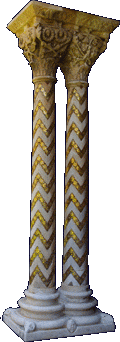| |
|
2010 Activities: Reports |
| |
X-ray techniques in investigations of the objects of cultural heritage. |
|
 |
| |
|
Around Rembrandt and his workshop
Scientific Achievements in Art
3rd meeting, Krakow, Poland, 13-16 May 2010
Collegium Maius of Jagiellonian University
http://www.heritagescience.pl/workshop
> book of abstracts (pdf)
Organizers
Faculty of Chemistry, Jagiellonian University,
Jagiellonian University Museum,
Institute of Catalysis and Surface Chemistry, Polish Academy of Sciences.
In co-operation with International Union of Crystallography, Commission on Crystallography in Art and Cultural Heritage.
International Scientific Committee
Professor Henk Schenk,
Amsterdam University, the Netherlands,
Dr Eric Dooryhee,
Centre National de la Recherche Scientifique, France,
Dr Thomas Wroblewski,
Deutsches Elektronen-Synchrotron, Germany.
Local Committee
Prof. Grażyna Stochel
Prof. Stanisław Waltoś
Prof. Małgorzata Witko
Prof. Wieslaw Lasocha
Prof. Roman Kozłowski
Alicja Rafalska-Łasocha
Anna Jasińska
Jolanta Pollesch |
|
| |
In May 2010, the 15th century Collegium Maius of Jagiellonian University in Krakow housed some 50 scientists and museum professionals discussing scientific achievements in art. This meeting was the 3rd in a series organized by scientists from Krakow. It focused on investigations of historic materials such as pigments and metal alloys and on corrosion and deterioration processes of objects by X-ray techniques and related methods.
The opening lecture by Roman Kozłowski (Institute of Catalysis and Surface Chemistry PAS, Krakow) dealt with climate-change effects on Europe's cultural heritage and with the associated initiative "Climate for Culture", an EU project running until 2014. However, the main part of the meeting was devoted to the paintings of Rembrandt (wiki) and his school. |
| |
Claudia Laurenze-Landsberg (Gemäldegalerie, Berlin) lectured about Neutron-Activation-Autoradiography of paintings. The Gemäldegalerie is known worldwide for its excellent Rembrandt collection and Claudia showed the results of about seventy 17th century paintings, many of Rembrandt. "Autoradiography taught us how Rembrandt's compositional sketches changed in time, from under-modelling a complete composition in umbra to finally a simple sketch in bone black" concluded Claudia.
X-ray radiography and IR spectroscopy revealed that Girl in a Picture Frame by Rembrandt (Royal Castle in Warsaw, see picture) was painted on a sketch of another woman. The signature on Scholar at his Desk was done in wet paint, whereas in the case of Girl in a Picture Frame it was probably added later.
Anna Grochowska (Czartoryski National Museum, Krakow) pointed out that Rembrandt used specially prepared very fluid paints in Landscape with Good Samaritan, making brown and black colours semi-transparent. Probably thanks to this feature the painting survived four centuries almost unaffected by crackle finish. |
|
 The Girl in a Picture Frame, 1641, oil on canvas, Royal Castle, Warsaw ; > image source (wiki) The Girl in a Picture Frame, 1641, oil on canvas, Royal Castle, Warsaw ; > image source (wiki) |
| |
Curators from Wawel Royal Castle (wiki) and Jagiellonian University Museum (Krakow) described The Portrait of a Young Man and The Scholar in his Study. The artistic values are undisputable; however, they are probably painted by artists from Rembrandt's workshop. Future scientific efforts should add information to the stylistic and technological studies to clarify the uncertainties.
The last lecture was "Rare Silverpoint Drawings by Rembrandt in the Focus of SR-XRF" by Ina Reiche (Centre de Recherche et de Restauration des Musées de France, Paris). Silverpoint drawings are most valuable treasures in art collections, for which only non-destructive highly sensitive analytical methods can be applied. She illustrated how SR-XRF analyses reinforce art-historical assumptions on genesis and dating of objects.
Many more lectures and posters were presented at the meeting. A full report cannot be given but the abstracts may be found on the workshop's website, the abstracts (pdf) are also available here. All posters were also shown to many hundreds of people participating in the Krakow Science Festival, organized every year by the higher education institutions. The participants of the meeting could visit the Jagiellonian University Museum and other museums on Krakow Museum Night.
The aim of this series of meetings is to bring together scientists from relevant disciplines with museum professionals (conservators and curators) responsible for the organization and preservation of art collections. The series is also listed by the IUCr Commission on Crystallography in Art and Cultural Heritage (CrysAC). The organisers can be congratulated that this aim has been fulfilled so nicely by this meeting in the great ambiance of Krakow.
Henk Schenk and Alicja Rafalska-Lasocha |
|
| |
|
|
|
| |
|


